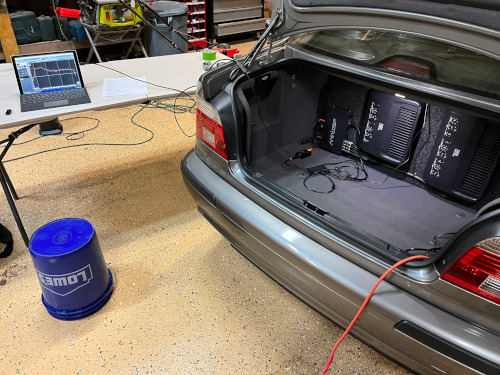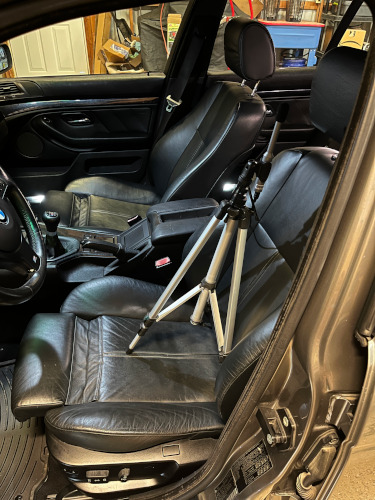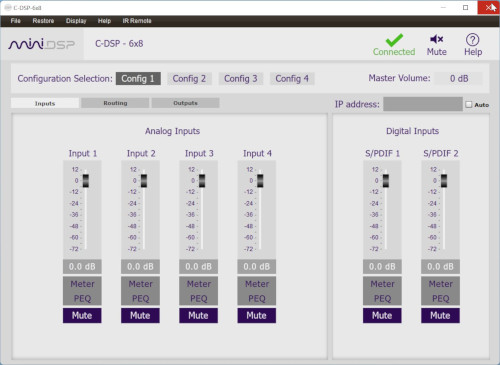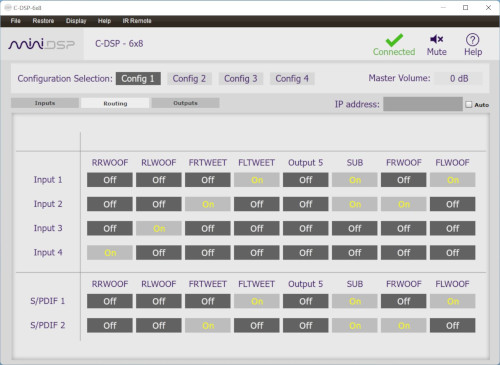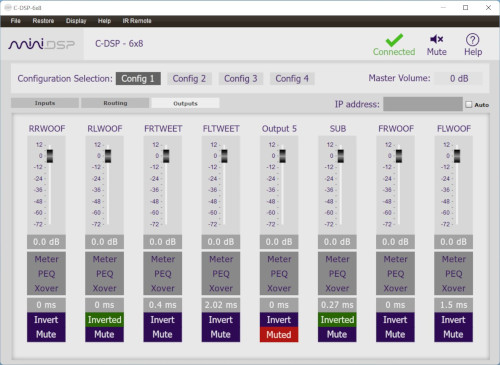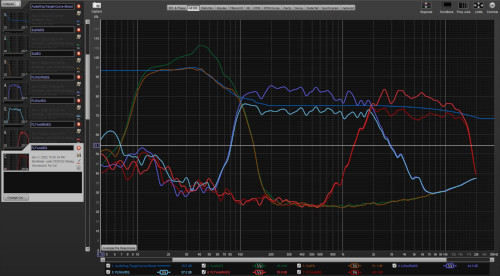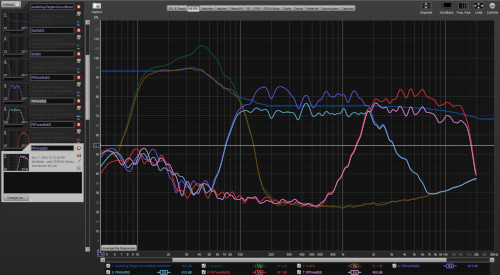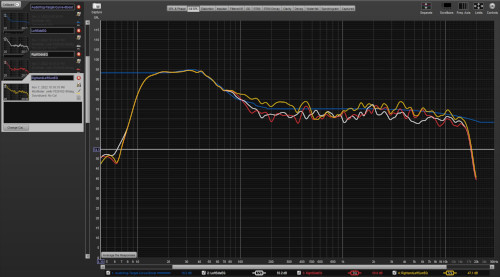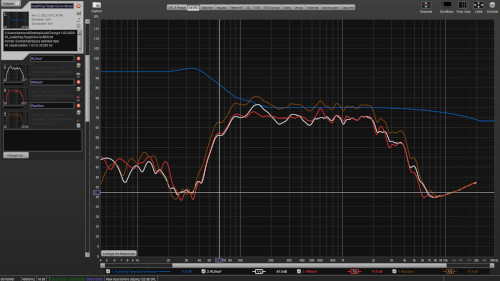Tuning - Round 1 - 11/04/2022
Time to see how well I did. I'd love to say this process was concise and end with some perfect response graphs, but in reality, this was a tough and lengthy job. A lot of my preconceptions were broken down and I had to repeat certain steps / processes multiple times due to errors or assumptions that turned out to be incorrect.
Even though, at this point, I've netted better results than stock, I still feel like there is still a lot of potential on the shelf that could be pulled out of this system with a better understanding of the process. Therefore, I'm only calling this round 1.
To do the work I setup a little rig that connected my laptop to the DSP, UMIK-1, and a SPDIF Encoder. On the software side of things I mainly used REW and Minidsp's C-DSP 6x8 tuning program.
I pretty much followed Audiofrog's "A Straightforward One-Seat Stereo Tuning Process and Some Notes About Why it Works" guide to the T or at least everything I could understand. That meant that my process basically went like this:
Polarity Confirmation, Time Alignment / Delay Setup, Crossovers, Levels, EQ, Confirmation, and additional level adjustments.
Polarity Confirmation: Pretty straight forward. I did all my own wiring and everything was color coded, so I actually skipped this and banked on seeing summing nulls if there was a wire cross-up somewhere. Luckily I didn't have any issues here. I still wouldn't recommend skipping this step like I did.
Time Alignment / Delay Setup. This one was a doozy because spun my tires like crazy several nights in a row trying to be smart and use REW's built in time alignment tools. Without a lot of documentation on the process + getting turned around several times when I lost track of how delays should be oriented I made things a lot worse before they got better.
I ended up just measuring all the distances by hand from each speaker to the calibration microphone like Audiofrog's guide suggest and got my best results that way. Afterwards, I used REW's acoustic timing reference option in my sweeps to calculate the system delay between two speakers and that helped me close in the last fractional milliseconds of my delays on my tweeters & woofers. However, it never worked for the subwoofer. REW kept spitting out huge numbers (like 8ms) for a couple of feet of distance on the sub so I knew it was way off and ended up keeping my measured distances for the sub.
Crossovers. Another area that would seem pretty straight forward, and for the most part it was. Audiofrog's guide suggest using 4th order Linkwitz-Riley 24 dB/oct filters due to their relatively steep slopes and ability to sum flat when speaker polarity is correct. While I didn't have issues with polarity nulls (which would indicate one speaker has the wrong polarity), I was getting positive humps at my crossover points, and after fiddling with it over a few days time I never could get my crossover points to sum flat (which I suspect has to do with a slightly incorrect choice of the crossover frequency) so I compromised (for now) and ended up utilizing 5th order Linkwitz-Riley 48 dB/oct filters that netted flatter crossover points. This is something I intend to revisit in round 2.
Levels. The speaker levels were pretty straight forward. I ended up settling on the Audiofrog house curve with my only modification being that I boosted the 0-140Hz range 2x. During testing, all input signals were sent over at -20dB making my respective low range target 95dB (for an eventual reference level of 115dB) and my respective mid-high range target 85dB (for an eventual reference level of 105dB). To get my speakers in the ballpark I simply plotted my house curve and did a -20dB input sweep on each speaker to see what kind of levels it put out inside its crossed over range. From there I simply raised my amp gains until each speaker's response was a couple of dBs above the target to leave room for the next step... EQ
EQ. The whole reason I started this journey! Finally time to see parametric EQ do its thing! While exciting, this is where I stopped short 50+ times after detecting mistakes in the steps before. Time alignment and Crossover settings were the big culprits here. Mistakes made early reared their ugly heads here. After hours and hours of work over several weeks I was finally getting respectable results / corrections. While not perfect, they'll do for round 1 and I'm very happy with the way things are sounding
Levels V2. After EQ, there was a little more fiddling with the levels since up to this point I was only EQ'ing speakers on the left or speakers on the right (+sub). I found that each side needed a little reduction in gain so that the sum wouldn't overshoot the target curve.
Levels V3. This is less round 2 and more homework for round 1. All of my tuning was done via my laptop > USB to SPDIF converter > C-DSP 6x8 SPDIF digital inputs. I felt like this was the cleanest inputs to work with and since my planned headunit would use this path for it's communication with the C-DSP it's what I chose. However, I found out afterwards, that the input levels for the C-DSP analog inputs (bluetooth dongle and the standard aux in), had significantly less gain than the SPDIF digital inputs. So, once the headunit is in I'll most likely do a few more sweeps on all the inputs to determine the sweet spot to balance all 3 inputs.
Rear fill or lack thereof. Something I haven't talked about yet is my rear speakers. I've got them and they're piped through the DSP and amplified, but I won't be using them for the most part. The reason for this is because the C-DSP 6x8 doesn't support differential rear fill, which, IMO, is needed to keep the front sound stage in tact. The easiest solution for me was to just drop them from the primary speaker group and only assign to the aux input which I plan to use with the eventual kid's rear entertainment along with a headphone system for quiet operation.
